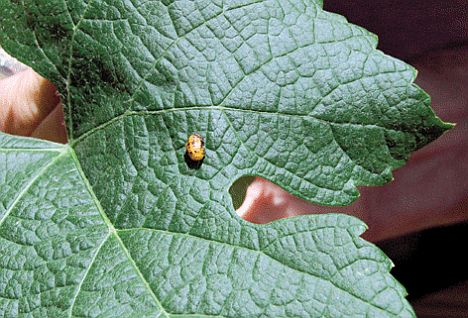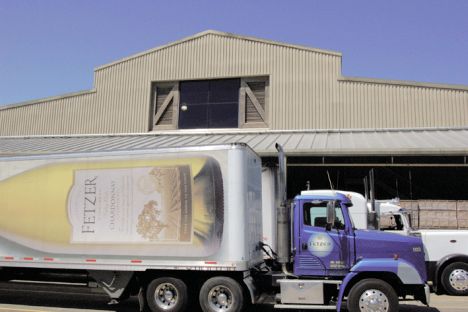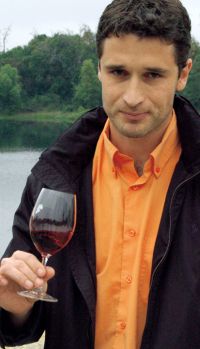Evil, pious people have always suspected, is a sweet fruit, flattering and seductive. It entices with its luscious fragrance, is soft and cuddly, beguiles by slowly clouding the senses of the unsuspecting - and thus resembles the plush wines of the New World. For this reason, it is considered by some to be the realm of the Dionysian god: With its rebellious stirrings against the divine order of the cadastral vineyard, with its lack of respect for the limits of all-encompassing large-scale vineyards, with their disregard for the ten commandments - from God-fearing must enrichment with holy beet sugar to humble wine fining with the help of tried and tested gifts from heaven such as gelatine and chicken egg white - with all their unorthodox methods and lax laws, in the eyes of European wine Pharisees the wine producers of the New World are going outside the community of the good and righteous who believe that they alone produce wine in a God-pleasing way. Oh, how bravely the pious resist the temptations of the serpent, which are called: oak chips and fractionation centrifuge.
The phylloxera - a pest with a migration background
Well, it is true that the most terrible disaster has befallen Europe's vineyards from the wine regions of the United States. But that was almost a hundred and fifty years ago. It was phylloxera that stowed away from North America to France in the middle of the 19th century, attacked the vine roots with its voracious proboscis and destroyed almost all of Europe's vineyards in the following decades. At least America subsequently provided the cure: Since phylloxera cannot harm the grape varieties native to America, today vines are generally planted as double-deckers: a European noble grapevine is grafted onto an American root ("rootstock"). The resistance to phylloxera is the only advantage of American vines: The wine produced from them is not very tasty.
 |
| Not all insects are as dangerous as phylloxera. Today, beneficial insects are deliberately introduced% in order to reduce the use of pesticides |
Hippies are the first ecologists in California
If the good defenders of European values ate from the tree of knowledge, they might gain some surprising insights. Perhaps they would remember that in the early seventies of the last century, the hippies in the USA, preferably in California, rediscovered nature-based agriculture. They might have noticed that what began with chemical-free carrots, nurtured by long-haired tousles, found its seamless continuation in viticulture and resulted in a surprisingly large movement. One of these hippies was Barney Fetzer, who respected creation in his own way: he not only gave birth to eleven children, but also laid the foundation for the largest organic winery on earth. The first Fetzer wine came onto the market in 1968. Nevertheless, Fetzer was not the first organic winegrower: at that time, the Sander winery was already doing organic winegrowing in Germany, more precisely in Rheinhessen.

Hemp labels and ink made from soya
In the meantime, the extended family has sold the property, but the seven hundred and thirty hectare vineyard is one hundred percent organically farmed. Part of it is even certified as "biodynamic" according to the extremely strict guidelines of the Demeter association. And the commitment is not limited to the grapes: labels made of hemp fibre, ink made of soya, passive-energy buildings, natural gardens - although the Fetzer empire with brands such as "Bonterra" is now wholly owned by the beverage multinational Forman-Brown Corporation, the commitment to organic issues continues unabated. Greenery and renaturation are the order of the day. Solar panels and nesting boxes, waste avoidance and energy-saving light bulbs - the whole basics of environmental protection are practised here. The farm has its own "manager for ecological development", who is also the managing director of the "California Sustainable Winegrowing Alliance".
Integrated and sustainable
"Sustainable winegrowing" is the new magic word, and this environmentally friendly method of cultivation is strongly promoted by the state in California. Sustainable winegrowing is roughly equivalent to our "integrated cultivation", a kind of "organic light". In essence, it means that the farmer or winegrower uses biological plant protection and, for example, prefers to use pheromones to scare off pests rather than destroy them with poison. It means that he thinks twice before he really goes into the field with a chemical sprayer. But he also keeps open the possibility of using chemical weapons against the fungal diseases powdery mildew and downy mildew, which are favoured by humidity, if it seems necessary to him. Because when the weather is so nasty that mildew threatens, the biodynamicist has to make a huge effort to blow the damp grapes in the vineyard dry so that they don't rot. The temptation to reach for the sprayer is great.
A little organic?
Convinced organic winegrowers, however, see spraying as needed as a soft compromise. Even infrequent spraying can upset the balance of a carefully balanced ecosystem. There is no such thing as "a little bit organic". On the other hand, a low and well-considered use of chemicals is always better than a thoughtless, wasteful approach according to the method "a lot helps a lot".
Eighty percent of the wineries, we are told, have already taken advantage of further training in sustainability. A quarter of the winegrowers are already consistently following this approach, and the trend is steadily rising. Especially the more sophisticated wineries are participating: the twenty-five per cent of participating wineries represent forty per cent of the value of Californian wine. Even the winery that European traditionalists consider the epitome of the Terrible New World has embraced the principles of sustainability: Gallo, the largest wine producer in the world, does not want to be an environmental pig and is very active in sustainability. A special recycling process for wine bottles has even been developed in the company's own glass factory. Exact figures on the total wine output are not given here.
Centrifuge against alcohol
 |
| Gallo oenologist Ralf Holdenried |
As a purely family-run business, Gallo is not obliged to provide comprehensive information. There are probably an estimated 600 million bottles, plus the same amount in larger containers. The grapes come from the two thousand hectares of vineyards the company cultivates itself and from purchased grapes from ten times that area. From huge vineyards in the undemanding Central Valley to small, fine sites in the Russian River and Alexander Valley in Sonoma County, Gallo can cover the entire spectrum from simple basic wine to luxury Cabernet. The question about the infamous spinning cone column, which breaks down wine into its components and, according to the fear, enables Frankenstein-style wine design, was answered by the oenologist of Gallo Family Vineyards, who comes from Rheinhessen, Germany, as follows: No, they don't have such a device themselves. But, yes, there is one in the neighbouring village that makes its services available to various wineries. Yes, Gallo also uses these services, but only for the purpose of alcohol reduction, because the wines here, due to the climate, sometimes reach up to sixteen degrees alcohol. And nobody wants to drink that.